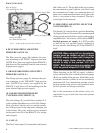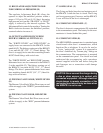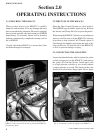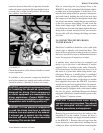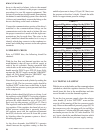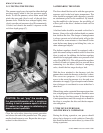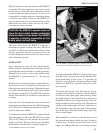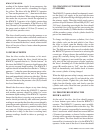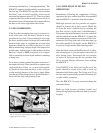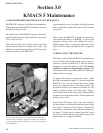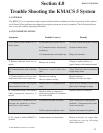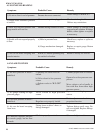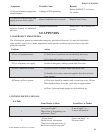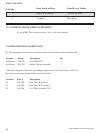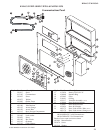14
KMACS 5 MANUAL
© 2003 KMDSI Document # 041112001
reading of the bottom depth. In an emergency, the
pneumo air can be used as a breathing air supply
for a diver. The diver tells the KMACS 5 operator
to “Turn on the pneumo-air...”, then inserts the hose
into the mask or helmet. When using the pneumo in
this mode the air pressure should be regulated by
the KMACS 5 operator to be slightly greater than
the diver’s depth. For example, if the diver is at 100
feet (30 meters), the pneumo should be opened until
the gauge reads a depth of 110 feet (33 meters), so
that a positive pressure exists.
The diver should practice using the pneumo as an
alternative air source under controlled conditions in
shallow water. The pneumo hose should be bubbling
when it is inserted in the diver’s mask, otherwise the
diver will receive a blast of water when the pneumo
is first turned on.
2.9 DIVER AT DEPTH
Once the diver reaches the bottom, or his maxi-
mum planned depth, the diver should inform the
KMACS 5 operator that he is, “On the bottom.” At
this time, the KMACS 5 operator should ensure that
he gets an accurate depth reading. The KMACS 5
operator should inform the diver that he is “Taking a
pneumo...”, when he opens the pneumo purge valve.
The diver should observe the end of the pneumo
hose and immediately inform top side that, “He has
bubbles...”. Once the diver has a flow of bubbles at
the end of the hose, the pneumo valve (D,O) should
be closed immediately.
Should the diver move deeper at any time during
his dive he must inform the KMACS 5 operator
and another pneumo should be taken for a new
maximum depth reading. If the KMACS 5 operator
knows that the diver is moving over an uneven bot-
tom he should periodically take additional pneumo
readings to ensure that the diver has not accidentally
gone deeper and neglected to notify top side. Keep
in mind, however, that every pneumo reading does
use some air. If high pressure air is the air source
and the dive is deep, or the diver is working hard,
pneumo readings should be taken as sparingly as
possible.
2.10 CHANGING OUT HIGH PRESSURE
CYLINDERS
The KMACS 5 operator should continuously moni-
tor the diver’s air supply at the two high pressure
gauges (L,M) when diving with high pressure air as
the primary supply. When the initial supply source
pressure drops to between 300 and 500 psi (20.7 and
34.5 bars), depending upon depth, the diver should
be switched over to the second air source using the
selector valve handle (I). While the diver is breathing
off the secondary source a fresh cylinder should be
put on line immediately.
To change out high pressure cylinders, first close
the cylinder valve on the tank which is low. Once
the valve is closed, open the bleeder valve on the
yoke (S) and allow the pressure to bleed from the
line. The high pressure whips are color coded to help
the KMACS 5 operator to ensure he is selecting the
correct one. Always observe the umbilical pressure
gauge (B) carefully during this procedure. If the
KMACS 5 operator is not careful he may acciden-
tally turn off the high pressure cylinder supplying
the diver’s breathing air. If the umbilical pressure
gauge (B) needle starts to “fall”, turn the cylinder
back on immediately and double check to ensure
the correct cylinder is being changed.
When the high pressure whip is empty, unscrew the
knurled knob on the yoke (S) and attach the yoke
to a fresh cylinder. Tighten the yoke knob finger
tight, close the bleeder valve, and slowly open the
cylinder tank valve. Read the new pressure on the
appropriate gauge (L,M).
2.11 PROCEDURES DURING THE
DIVER’S ASCENT
At the end of the dive, the diver should prepare
to leave bottom upon orders from the KMACS 5
operator. The KMACS 5 operator must carefully
note the diver’s depth and time on the dive log. The
KMACS 5 operator is responsible for monitoring the
diver’s ascent rate which should not exceed 60 feet
(18 meters) per minute, or slower if a dive computer
is being used to monitor decompression/no decom-
pression status. The diver should not leave the bot-
tom until he is instructed to do so by the KMACS 5
operator. At the start of the diver’s ascent he should



